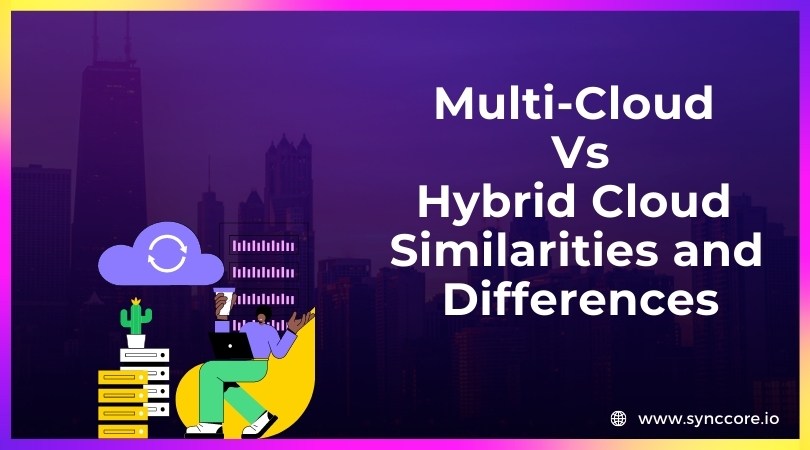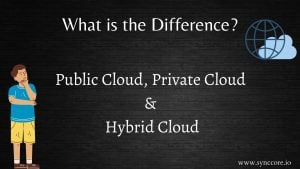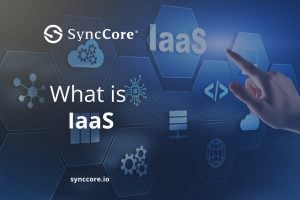There is no single cloud computing model available now. Cloud technologies have evolved, grown, and increased to meet enterprises’ most demanding business needs.
The development of cloud technologies is particularly perplexing for enterprises new to cloud adoption, and the distinction between multi-cloud and the hybrid cloud can be mysterious. Both designs have their definitions and objectives. We’ll dissect them here and give you some pointers on choosing the appropriate architecture for your apps and business objectives.

Table of Contents
What is multi-cloud?
Two or more cloud computing platforms or providers are used in a multi-cloud technology approach to address distinct business needs.
A multi-cloud strategy might be broad and complex depending on the number of clouds involved and how a business utilizes each cloud resource or service. For example, a company could use IaaS from a public cloud provider to host its workloads. It might also leverage specialist SaaS or PaaS providers for business services like productivity tools (Office 365), employee expense management and reporting (Concur), and so on, where each service has its cloud.
Benefits of Multi-Cloud
So why undertake such complexity? There are some compelling reasons why a business might explore a multi-cloud approach. They are as follows:
So, why take on such a challenge? There are several compelling reasons for a company to consider a multi-cloud strategy. The following are the details:
Reduce local infrastructure:
To relieve the responsibilities of hardware, software, maintenance, and support, a company outsources some or all of its on-premises infrastructure to third-party suppliers — for example, moving business email from an in-house Exchange server to Exchange Online.
Leverage specific services:
Clouds frequently specialize in complementing the provider’s business experience and capabilities. For example, a company might host a test and development workload on one cloud provider while using AI and machine learning (ML) services on a second cloud provider.
Manage costs:
Whether or not it is used, local infrastructure necessitates a financial commitment. Cloud resources and services operate on a “pay-as-you-go” model, with costs varying according to usage. A SaaS platform, for example, may charge by the number of users (seats), but other cloud services may charge by consumption or recurring monthly costs. Providers keep detailed records of these charges, so organizations can know exactly how much money is spent.
Improve resilience and compliance
The core principle of compliance is that a firm must continue to operate and stay secure in the face of disruption. To accommodate more significant application traffic and improve resilience, a company might install a redundant workload on two or more clouds. If one cloud goes down, the workload can continue to be supported by the other cloud.
Challenges of multi-cloud:
A multi-cloud strategy involves more than just juggling resources, services, and third-party providers. Organizations that adopt a multi-cloud architecture may face new risks and issues that aren’t typically associated with on-premises technology, such as the following:
Security complexity:
Multiple cloud providers and settings necessitate juggling multiple security configurations and authentications to assure user and sensitive corporate data security. Establishing a standard security configuration or methodology for all cloud providers may be impractical. There may also be a high risk of security vulnerabilities in multi-cloud settings.
Regulatory standards:
Although multi-cloud techniques can help with workload resilience, there are also risks to regulatory compliance, such as incorrect data storage locations or data in the cloud that is not appropriately secured.
Network security:
Critical company data will inevitably travel through a public network like the internet with workloads and data in the cloud. Businesses must take extra care to protect the security of any cloud-related data by encrypting it.
Provider disruption:
A company must examine the consequences of network and provider outages and develop contingency measures. Understand the implications of a business-to-provider internet outage, a malicious attack on the provider, the discontinuation of critical services, or even the impact of a provider merger, acquisition, or bankruptcy. It may be required to choose another cloud provider or bring the service back in-house.
Multi-cloud management tools:
Any organization using a multi-cloud strategy must be aware of the resources and services it employs and their configurations and performance.
IT departments can employ solutions to manage various clouds from a single location. These solutions support a variety of cloud platforms, including Synccore Cloud, AWS, and Azure, and related technologies for managing container-based workloads, such as Kubernetes. Multi-cloud management systems should also offer strong abstraction, orchestration, and automation; security, such as identity management and data encryption; policy governance and compliance; infrastructure and application performance monitoring; and cost management.
What is a hybrid cloud?
A hybrid cloud computing strategy combines a private cloud, on-premises infrastructure, or both with a public cloud environment to create a single cloud computing environment that combines the best of both worlds.
A company might build a private cloud to assist software developers’ self-service resource provisioning or run a critical cloud-native application locally. The company can also connect its private cloud to a public cloud to access additional resources and specialized services.
Types of hybrid clouds
Uniformity is the cornerstone to a hybrid cloud’s success, as it allows for consistent access to and delivery of resources and services across public and private clouds. To create a homogeneous hybrid cloud infrastructure, there are two main techniques.
The typical way is to build a private cloud stack utilizing standard platforms like OpenStack to interface with a public cloud. Because the resulting hybrid cloud infrastructure incorporates technologies and media from a range of suppliers, these are commonly referred to as “heterogeneous” hybrid clouds.
Another option is to employ dedicated appliances that include a software stack and services tailored to work with the desired public cloud. Azure Stack, Google Anthos, and AWS Outposts are some examples. Because the resulting infrastructure comprises technology from a single public cloud provider, these hybrid clouds are frequently referred to as “homogeneous” hybrid clouds.
Benefits of hybrid cloud
A hybrid cloud strategy may be implemented for a variety of reasons, including the following:
Cost management:
Infrastructure is a sunk cost, and some workloads and data will always require local infrastructure; a company may choose to establish a quick and flexible private cloud with on-premises systems. Meanwhile, other workloads and data can be moved to the public cloud as needed to take advantage of “pay-as-you-go” or “pay-per-use” models. By combining these public and private clouds into a single hybrid cloud, workloads and data may be easily moved as cost savings allow.
Security and compliance:
Some workloads and data must run on local infrastructure for security, compliance, and regulatory reasons. A hybrid cloud allows the company to design and implement standard security and compliance policies to address regulatory issues.
Scalability:
As traffic ebbs and flows, workloads may require the flexibility to add or remove resources. Workloads and data can be moved between private and public clouds as needed via hybrid clouds.
Business agility:
Rapid infrastructure provisioning is commonly used to support new workload testing, deployment, and migration operations, which provides competitive advantages, new business prospects, and faster time-to-market. Staff can provision resources on a private cloud, then shift workloads and data between public and private clouds, making a hybrid cloud strategy ideal for agility.
Challenges of hybrid cloud:
While a well-designed hybrid cloud can provide significant benefits for a busy business, there are several disadvantages to consider, including the following:
Lack of capability:
Building a hybrid cloud from the ground up, especially a patched-together heterogeneous hybrid cloud, can be time-consuming and technically complex. Not all mixed cloud projects succeed or meet the needs of the enterprise. Before implementing a hybrid cloud program, a company must have strong personnel skills and tools and move in carefully coordinated phases.
Costs:
While hybrid clouds can help with overall cost control, maintaining additional private cloud equipment and developing new workflows and norms for private and hybrid cloud use is still costly. When creating a hybrid cloud project, think about all of the costs.
Integration problems:
The fundamental goal of a hybrid cloud is to combine private and public clouds, yet doing so is one of the most challenging tasks. (Hybrid cloud products that are homogeneous make this a lot easier.) In addition, the hybrid cloud may need to be maintained with adjustments and upgrades to keep up with changes to the infrastructure or software stack of the public cloud provider.
Network disruption:
WAN connectivity is essential for hybrid clouds. The hybrid cloud could be rendered inoperable if there are any disturbances.
Can a hybrid cloud be multi-cloud?
Hybrid cloud and multi-cloud are often viewed as independent techniques or architectures, each with their purpose due to their similarities and differences.
Hybrid clouds and multi-clouds, on the other hand, can coexist. A company can develop a private cloud for internal usage, merge it with a public cloud to create a hybrid cloud, and then add or integrate numerous clouds (IaaS, PaaS, or SaaS) to provide specific resources or services. Similarly, a company might build a hybrid cloud with one public cloud provider while using the resources and services of other public clouds outside of the hybrid cloud.
A “hybrid multi-cloud” might theoretically be created, but this would necessitate a private cloud that simultaneously integrates two or more public clouds. In practice, the numerous technical challenges that such simultaneous integrations entail are rarely worth the time and effort. Only the largest and most technically capable companies with complex hybrid project requirements should consider such a venture.
How to choose which cloud is best for your business
The general criteria for selecting a hybrid or multi-cloud strategy can be boiled down to a question of control or ownership. The decision isn’t always obvious or straightforward, but unique company demands and objectives always guide it.
When to choose a hybrid cloud strategy
A company needs cloud flexibility, resources, and services. Still, it is required (by choice or legal criteria) to host some data or workloads locally and can’t move them outside of its on-premises data centers or direct geopolitical control. For example, a company may desire to develop cloud-native applications and host part of them in the public cloud, but specific essential tasks must be executed locally.
When to choose a multi-cloud strategy
Services, resources, infrastructure, and cost models provided by distinct cloud providers are required by a business. For instance, a company might choose VM and storage instances from one public cloud provider, business applications (such as productivity or finance) from several SaaS providers, and possibly AI/ML cloud services or language cloud services from other cloud providers.
Always choose a cloud architecture based on your company’s specific demands and objectives. There is no such thing as the “best” cloud. Instead, be aware of the complexities and difficulties that each cloud choice entails.
If you need cloud services, send a mail at [email protected] or Learn more at www.synccore.io.



